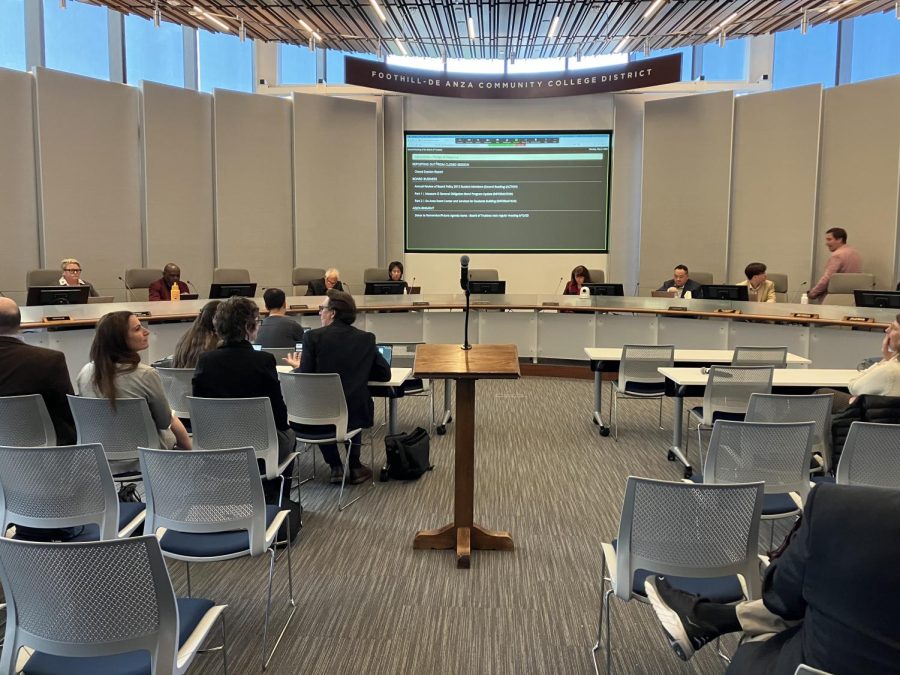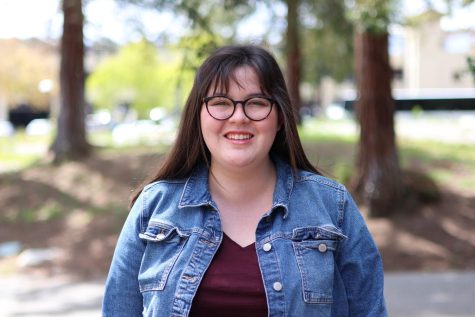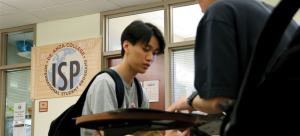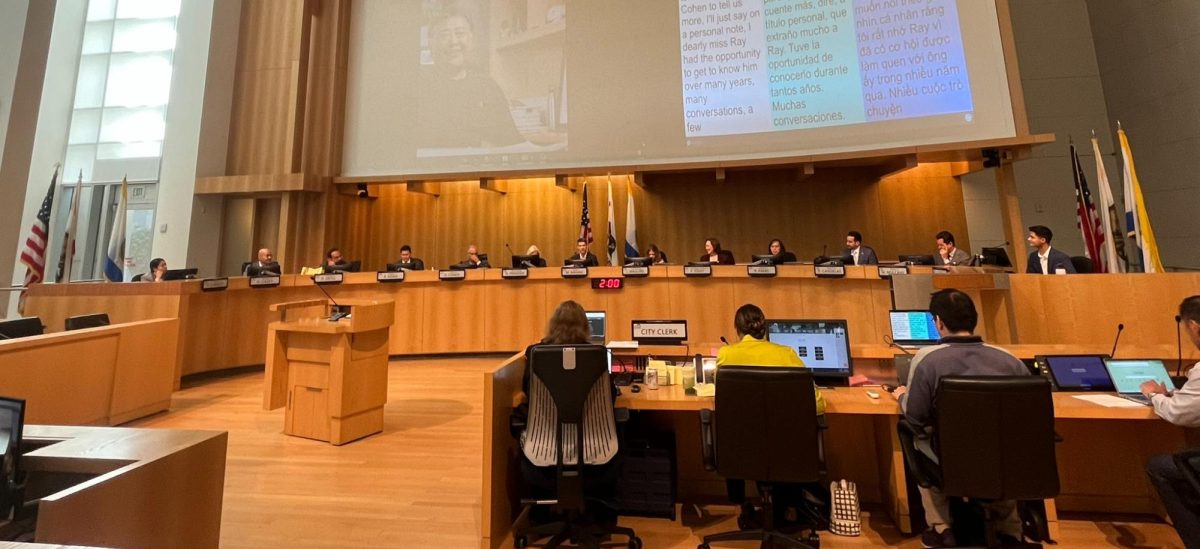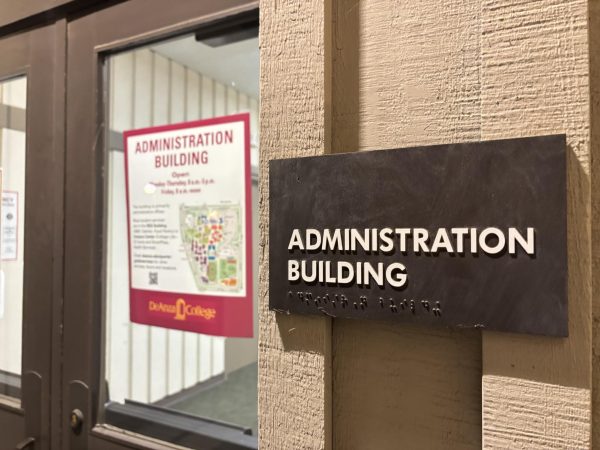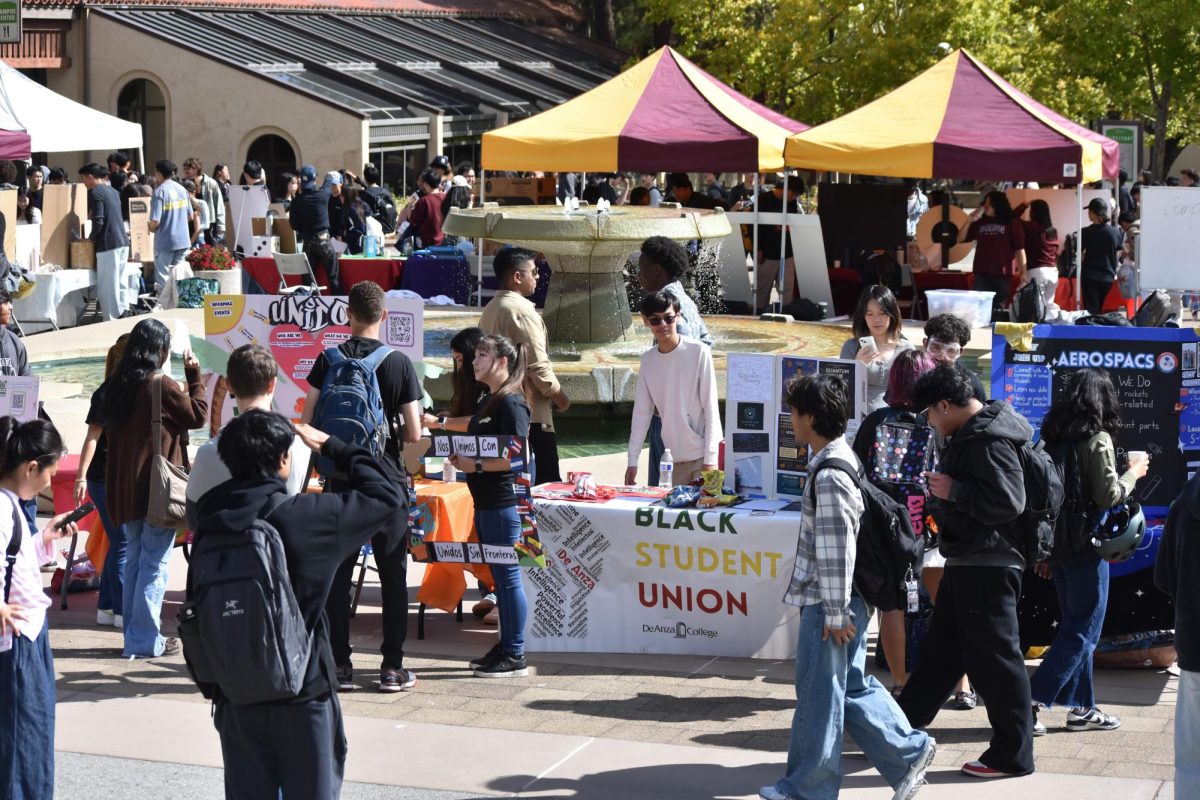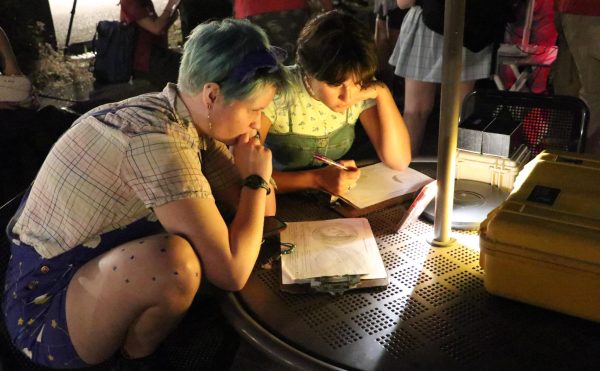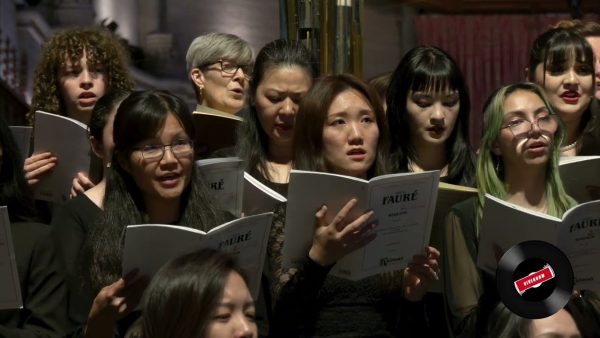District board overturns Measure G megaprojects and establishes timeline for spending decisions
The Foothill-De Anza Board of Trustees prepares to start the Measure G Board Study session on May 8. In the audience were stakeholders interviewed for the feasibility study, Foothill-De Anza students and faculty, and members of the general public.
June 9, 2023
The Foothill-De Anza Board of Trustees overturned proposed plans for spending the $898 million Measure G bond and moved to redirect resources toward other purposes during their meeting on May 8.
De Anza College President Lloyd Holmes presented his plans for Measure G to students and faculty, explaining the administration’s goal of building a new Event Center on campus to replace the now-defunct Flint Center. This study session served as a second major update in Measure G plans after students and faculty raised concerns regarding communication about these plans and no permanent spaces being designated for the arts.
The meeting started with two research consultants, Bill Blake and Amy Ben-Kiki, presenting their findings on the feasibility of building a new Event Center through analyzing supply and demand for the venue
The first thing they reviewed were the results from 46 stakeholder interviews they conducted, which included organizations ranging from DASG and De Anza faculty and staff to the Cupertino Chamber of Commerce and Santa Clara County Supervisors.
“In these interviews, we had a few consistent themes emerge,” Ben-Kiki said. “We heard that the primary group that the Event Center should serve above all the others is the students of De Anza. This was often framed in contrast to the Flint Center, which was seen as not having been part of the student life.”
The research consultants also reached out to audiences for a new Event Center or performing space, gathering a total of 337 survey respondents over six weeks, consisting of 141 De Anza students, 108 De Anza employees, 78 community members and 10 classified as “other.”
Ben-Kiki showed some of the answers De Anza constituents and outside community members gave to the question: “What value would the Event Center bring to the community?” She explained which response received the highest consensus between these two groups.
“Over two-thirds of both groups agree that bringing the campus and public together would be a value that the Event Center would bring,” Ben-Kiki said. “That’s actually the only value that over 50% of De Anza students and employees agree with.”
However, she pointed out that the two groups disagreed on whether or not the Event Center would improve life for locals in the Cupertino area.
“Interestingly, 80% of the community members felt that a new Event Center would improve the quality of life for Cupertino residents,” she said, “and only 46% of De Anza affiliates did, so there’s a real disconnect on that one.”
In this same survey, 12% of respondents opposed a new Event Center being built.
Ben-Kiki said that the survey did not explicitly ask the question of whether or not there should be a new Event Center, so people gave negative feedback when asked to share anything else they wanted the consultants to know.
“You can see representative quotes (from those that opposed the Event Center) came from both De Anza affiliates and from community members,” she said. “For example: not sure an Event Center is needed or will make money; as a community member, no (Event Center) needed, available elsewhere; plenty of venues in the South Bay; and our classrooms are needed.”
The consultants also collected and evaluated responses from people who would use the facility by presenting their content in the venue. Blake explained that the potential user survey was open for four months and sent to 54 local organizers and promoters, 18 of whom responded.
“The demand is clustered around a venue with 850-1200 seats,” Blake said. “We didn’t catch a lot of use for a performance-based venue from users, both off-campus and on. The demand only accounts for 26 days of use (a year).”
At the end of the presentation, the consultants gave board meeting members three choices to discuss moving forward, which were to “meet” the market, to “make” the market or to redirect resources elsewhere.
The first option involves designing and developing a series of smaller, flexible spaces. The second option involves designing a multi-use event space for college-driven programs.
“Build something very flexible and dynamic that can convert to flat floor space, which would be unique in the market for the many things it can do,” Blake said. “We do not see that renters would be beating a path to your door, so that would be incumbent on the college and management of a new center to go get that business and then service those events well.”
The third option entails refocusing the “Event Center” concept and directing resources to other priorities such as renovations or improvements to pre-existing assembly and arts buildings.
“To tee up what you might want to think about,” Blake said, “(consider) this concept of an event venue and what its real purpose would be given that you want to serve the student needs first, community needs second and have some revenue opportunities – if possible – third.”
After listening to the consultant’s presentation, board President Patrick Ahrens said that he wanted the board to analyze the current plan using market results and put together a more definitive plan on how to move forward.
Ahrens then turned it over to De Anza President Lloyd Holmes to introduce the final slide of the presentation, explaining two main topics of discussion for the rest of the meeting. President Holmes said the board needed to give input on future courses of action so he could pass that information on to the newly-formed Measure G taskforce.
“Do we continue down the road we’re on based upon the information that we’ve received?” Holmes asked. “Can we modify the space per the AMS feasibility study? Initially, we were talking about building a performing arts space with at least 1,000 seats, or building an event space flat-floor with 800 to 1,000 seats that people can use.”
He also addressed the possibility of scrapping plans for a new Event Center.
“We have to be able to answer the question of whether or not we even want to build this Event Center,” Holmes said. “I want to make certain that, as the task force is working to move things forward on our campus and engage with our constituency groups, we have a very clear direction from the board.”
Holmes turned it over to Susan Cheu, the vice chancellor of business services, to give her perspective on the situation.
She agreed with Holmes’ statement about deciding whether or not the board wants an Event Center, and also explained the original process of planning possible projects funded by bond money.
“When we initially went out for the bond, we had about $1.5 billion worth of need and had to whittle that down to $898 million,” Cheu said. “There were a lot of changes that were made as we moved along as a result of deciding to put the Event Center and housing as two of our priority projects.”
She also addressed some budgetary concerns that could arise if the Event Center is not built.
“If it’s not built, (we need to) look at those areas that were cut (in the initial budget) and then look at some projects that are coming in over (budget) – the inflation cost cannot be underestimated at this point,” she said. “The task force can be a start in deciding the yes or no question (of building the Event Center) and then what comes next would be a broader conversation.”
President Patrick Ahrens asserted the need for the board to give “scaffolding” to the De Anza Measure G taskforce so they could be “set up for success.” He also shared some of his thoughts on the findings from the feasibility study.
“There are a couple things within this presentation that are very clear to me, which is that there isn’t a market for a formal Event Center, and that we tried this before – it’s called the Flint Center,” he said. “That’s not something we wanted. I’m certainly not in favor of making the market because I can’t get behind a venue that’s going to be operated only 26 days of the year.”
The board opened up to comment from public attendees. Amy Huang, the DASG president and a student representative on the task force, said she saw no need for a new Event Center.
“There’s an under-utilization of on-campus resources, including Smithwick Theater and VPAC,” said Huang, 24, a business tri-major. “When I was trying to host a Measure G event, we tried getting an MLC room and I was told that students are not allowed to rent out any rooms at MLC, even though I had the assistance of (academic senate president) Cheryl Balm as one of our liaisons. What I find unfair is that we’re talking about building this entirely new thing, but then we aren’t even able to rent out rooms that already exist on-campus.”
Huang also drew attention to the issue of the arts quad being displaced in plans for the new Event Center, citing the “frustration” of students and faculty in the department. She said that the construction of a new Services for Students Center is not needed.
“We need a student union, not a student services building,” Huang said. “We need a student union where students are able to hang out there but also access those facilities. Just having the facilities isn’t enough – it’s about students having awareness of those facilities, constantly passing by those facilities and being able to redirect other people through word of mouth.”
Academic senate President Cheryl Jaeger Balm highlighted the original idea behind relocating the arts quad and proposed using the bond money on upgrading the infrastructure of creative arts buildings.
“As we were talking about building the Event Center, one of our vice presidents said that we need to relocate the arts quad because if they were a student, they would be embarrassed to show our facilities to their parents,” Balm said. “If we take this $100 million and we don’t primarily use it to help out the creative arts after all that was said about how terrible their facilities are, there’s going to be a lot of frustrated people at De Anza.”
Anu Khanna, an intercultural and communications professor at De Anza, said the conversations around the Event Center should be reframed.
“Instead of calling it an Event Center, what if we just called it a multipurpose facility that serves both the students and the community?” she asked. “Can a mandate be that we explore how to really maximize both opportunities? Maybe not at the scale that we were originally thinking of, but could we see where the opportunities lie?”
After consideration based on ideas presented above, Ahrens suggested the board issue a general directive to the task force to redirect resources and hear what the individual campuses have to say regarding these possibilities. Nonetheless, he emphasized the need to be “intellectually honest” about what projects can be completed while still staying within budget.
“It seems to me that building what I have heard in the past would be a $50 million new arts facility, a 60-some-odd million student services center and a multipurpose or community center is not feasible,” he said. “We’re going to be living within our means. We’re going to be providing general direction to the taskforce so that they don’t come back to us with a wildly unfeasible set of expectations of building all three or four of these things.”
Cheu then discussed when she could return estimates for different proposed projects. She said she could quickly give rough estimates with the assistance of Joel Cadiz, the district executive director of facilities and operations, but final estimates would take longer.
“We can pull out the resources that are available for the Event Center, the student services building, and swing space for the arts,” she said. “Joel Cadiz can give some very round numbers of what things might cost in terms of updating an arts quad and updating audio-visual equipment. We need to get a consultant to give really hard numbers, but I would beg that we don’t do that until July because we have a tentative budget coming up in June.”
Ahrens set the deadline for Cheu turning in a budget for different options to the taskforce for July, with some leeway until August. The board also agreed on doing a brief check-in with the taskforce in July to follow some of the progress they make in decisions based on those estimates.
Balm explained her thoughts regarding the timeline.
“I hear, ‘oh my god, we have to move fast,’ and I understand prices are increasing,” she said. “We’ve had this bond for years, and this is a huge change in plans, so while I have no problems with a small check-in during July, I just hope that we don’t let the rising cost of construction cause us to make poor rash decisions that both end up with a bad facility and hurt feelings. I felt the need to say that and now, go July.”
Ahrens closed up the meeting with one last point.
“For the record, this board has a commitment of delaying and delaying, so that never will occur, and that’s a promise,” Ahrens said. “We’re moving forward. So with that, we’re clear on the timeline.”
Ahrens then set the next independent study session on Measure G issues for October, when classes would be back in session and students and faculty would be able to attend to give their opinions.



